Female Ancestors
Issue date: 7th May 2020
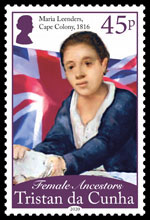 |
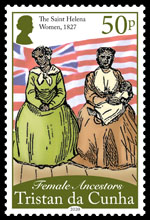 |
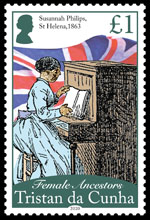 |
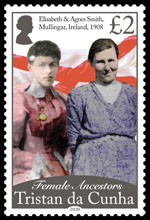 |
| 202005 | Mint Stamps (45p, 50p, £1.00, £2.00) | £3.95 |
| 202006 | First Day Cover (with 45p, 50p, £1.00, £2.00 stamps) | £4.95 |
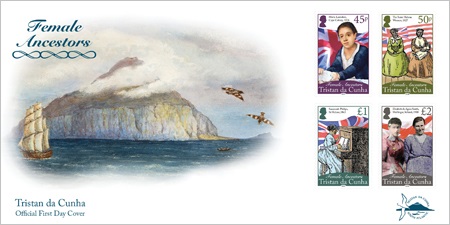
"Probably all the adjectives known to man have been used at one time to describe woman, but without doubt the one most suited to the women of the lonely community on Tristan da Cunha is 'unique'." So wrote the Cape Times in 1922.
While earlier stamp issues commemorating Tristan's family surnames have tended to focus on the community's male founders and their stories, their wives have equally interesting stories that are also worthy of celebration and commemoration. The island's founding fathers were white Europeans and Americans, but most of the founding mothers were of mixed race, which adds a further dimension to their stories. If the men's lives were hard, the women's were as hard if not harder, if only because of the perpetual round of childbirth they had to endure. It was even harder when most of the island men perished in the lifeboat disaster of 1885.
Stamp Design Details
| * Women who still have descendants on the island. | ||
| 45p | - |
Maria (Mary Magdalena) Leenders (1801-1858)*, Cape Colony, arrived 1816 Maria was one of the founding members of the community, arriving with her husband William Glass in 1816. Described as a Cape Creole, she married William, in July 1814, at an incredibly young age in the Cape Colony and bore 16 children. After he was stranded on Tristan in 1824, the artist Augustus Earle described the life of Maria and the only other woman then on the island, Peggy White, as follows: "Their time is so fully occupied that I seldom see either of them; being constantly in the cook-house, which is separated from our dwelling. Children there are in abundance, all healthy and robust, and just one year older than the other." Five of her sons werer engaged in whaling on American ships. Following the death of William, she emigrated with most of the family to New London, Connecticut, in 1856 to live with her son Robert Hill Glass, who had become a successful whaling captain, until her death in 1858. Her daughter Selina, who had married Captain Andrew Hagan, remained on the island. One of her sons, Thomas, who also remained on the island, was lost in the lifeboat disaster of 1885. The portrait comes from one of Earle's paintings, and the background shows the Union flag, which was used by the Cape Colony at that time. |
| 55p | - |
The St Helena Women, arrived 1827 The story goes that the five men living in "Bachelor's Hall" in the 1820s, badly feeling the need of female companions, persuaded Captain Simon Amm of the Duke of Gloucester to bring them five women from St Helena in 1827. Captain Amm made a request to the Governor of St Helena who wanted written assurance that the women would be looked after. The captain landed the women on the beach then made off, not staying to see the men's reaction to the women he had brought. The term "mail order brides" that is sometimes used to describe the women underplays the factors that may have made the move to Tristan seem appealing. It is possible they were former slaves and may have taken the surname of an owner in some cases. The five women were:
William Glass unofficially married the couples, as there was no clergyman on the island. The marriages were all legalised by Rev Taylor later on. The picture on the stamp shows island women in the 1860s, and comes from a woodcut published in The Graphic, 1875. The background shows the flag of the East India Company, which controlled St Helena in 1827. |
| £1.00 | - |
Susannah 'Susan' Martha Philips (1843-1932)*, St Helena, arrived 1867 Susan was a 'Saint' of mixed race, who met and married Tristanian Samuel Swain on St Helena in 1863. She bore two children on St Helena, and a further nine after the family moved to Samuel's home island. Samuel was lost in the lifeboat disaster of 1885 but Susannah remained on the island until her death in 1932. The picture also comes from the woodcut published in The Graphic. The background shows the Union flag, the Crown having taken over control of St Helena from the East India Company in 1834. |
| £2.00 | - |
The Smith Sisters, Mullingar, Ireland, arrived 1908 The three Smith sisters - Elizabeth, Agnes and Annie - belonged to an Irish family from Mullingar, Co. Westmeath. Their father was in the British army and the family had moved to Kokstadt in South Africa. They met and married three Tristanian men, who served in the Anglo-Boer War, two of whom were brothers. They all returned to Tristan in 1908. The three sisters were:
The pictures of Lizzie and Aggie come from family photographs. The background shows the St Patrick's flag, which represents the island of Ireland - both the present-day Republic of Ireland and Northern Ireland. |
| FDC | - |
Painting of Tristan da Cunha by Augustus Earle, 1824 The London born travel artist Augustus Earle was stranded on "Tristan d'Acunha" from March to November 1824. Earle arrived on the Duke of Gloucester with the same captain that brought the St Helena wives to Tristan in 1827. |
In addition to the women already mentioned, a few other women also came to Tristan but left without leaving any descendants.
- Margaret 'Peggy' Vass (c.1807-1841) was a mixed race Portuguese Indian, possibly from Bombay. She was travelling as a servant to a family on the Blenden Hall when it was wrecked on Inaccessible Island in 1821. While trapped on Tristan, she fell in love with fellow castaway Stephen White, a sailor, and they stayed when the other survivors were taken away in 1822. Theirs was the first marriage to be performed on the island. They both appear in the same painting by Augustus Earle as Maria Leenders. They had three children before they left Tristan in December 1826, two more were born in England and another four in Hobart, Tasmania where they eventually settled. Peggy died there in 1841.
- Frances June Reagon (c.1835-1930) of St Helena married Cornelius Mageen Cotton in Jamestown in 1869. They soon moved to Tristan and had five children. Frances and her young children relocated to Simon's Town, South Africa not long after the tragic death of Cornelius in the 1885 lifeboat disaster. She never remarried, and died in Simon's Town on 30th November 1930, aged 95. Many of her descendants still live in Simon's Town.
- Rhoda Ann Yon (c.1861-1918) of High Plains, Jamestown, St Helena married Thomas Gordon Glass Cotton on St Helena in May 1882 and moved to Tristan. Thomas also died in the 1885 lifeboat disaster, and Rhoda left Tristan with her children for the Cape where she died in the 1918 Spanish Flu epidemic.
- Catherine Bowers/Jacobs/Anderson (aka Lind) (c.1820-c.1897) was one of the St Helena born daughters of Sarah Jacobs. She married John Anderson, an American, who deserted from a whaling ship in 1839. John died in 1850 and soon after his death; his widow went away on a whaler, the Bengal, with all her children bound for Hobart Town, Van Diemen's Land, arriving in February 1851. A number of Catherine's children were placed in the Queen's Orphan School, in Hobart. Catherine and the remaining children lived in Hobart, before she married a widower, Charles Quinn on 5 Dec 1884. She passed away about 1897.
We would be interested to hear from anyone who has further information about any of these women or other overseas families with Tristan origins. Please email the Post Office at: postoffice@tdc-gov.com.
Technical Specifications from Pobjoy Mint Ltd.
| Designer: | Andrew Robinson | Printer: | Cartor Security Printing |
| Stamp size: | 28 x 42mm | Perforation: | 13½ x 13¼ per 2cms |
| Process: | Stochastic Lithography | Sheet Layout: | 10 |
| Production Co-ordination: | Creative Direction (Worldwide) Ltd | ||
